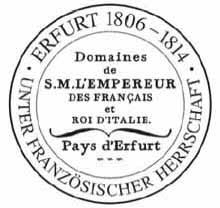Friedrich Wilhelm Facius
Friedrich Wilhelm Facius (born December 3, 1764 in Greiz ; † May 4, 1843 in Weimar ) is a German inventor, gem cutter, engraver and medalist .
Life
Friedrich Wilhelm Facius was born in 1764 in the Principality of Reuss-Greiz as the son of the merchant Facius in Greiz. His father urged him to learn the trade of a businessman , although Friedrich Wilhelm Facius secretly wanted to become an engraver. When he had learned the trade of a businessman and had saved a small sum, his father gave in.
In 1781 he left his father's business and went to Dresden to learn the art of engraving . After returning from Dresden, he worked as an engraver in Greiz for a few years. In 1788 Friedrich Wilhelm Facius moved to Weimar and was persuaded there by Johann Wolfgang von Goethe to learn the art of stone cutting . With the help of Goethe's information, he made his own tools and machines and successfully undertook his first attempts at stone cutting. He then went back to Dresden to be trained in his craft by the stone cutter Dettelbach.
After completing his training, he returned to Weimar and had his workshop as a stone cutter and engraver, where he made the heads of Homer , Mercur, Socrates , Hercules, Medusa, Hebe, Nemesis, Leda, Meleager etc. in stone and steel. Facius created many successful medals , including the portrait of Grand Duke Karl August and Goethe's. He also created the commemorative medals for the meeting of Tsar Alexander I and Napoleon in Erfurt in 1808, in 1813 for the 78th birthday of Christoph Martin Wieland for the Amalia Lodge in Weimar and later for his death and in 1817 for the farewell to Professor Paul Johann Anselm von Feuerbach from Jena .
Friedrich Wilhelm Facius was also an inventor. When the Weimar Castle was rebuilt after the fire of 1774 after thirty years of construction, he invented a stucco mass that over time reached the hardness of a solid stone and was used in the reconstruction of the castle. He gave his steel work an unassailable polish, the composition of which he knew only on his own. He also found a method of hardening medal stamps to prevent them from cracking. For times of war he made a diet from tragacanth that could be prepared in a variety of ways and essentially feed an entire family during times of war.
Of his five children, only his daughter Angelica learned the art of stone cutting and engraving and became an important sculptor and stone cutter who later far surpassed him in artistic importance.
At the age of 65, Friedrich Wilhelm Facius was appointed court medalist in Weimar on November 6, 1829 . On June 5, 1840, at the age of 76, he was made honorary professor. Friedrich Wilhelm Facius died three years later on May 4, 1843 in Weimar.
Friedrich Wilhelm Facius was drawn by Heinrich Müller in 1829 and by Friedrich Preller in 1837 and 1839 .
Works
- Medallion with a portrait of Johann Wolfgang von Goethe ,
- Medallion with a portrait of the Grand Duke Karl August ,
- Medallion at the Erfurt Prince Congress with the portraits of Emperors Napoleon I Bonaparte and Alexander I Memorial coin, 1808, silver, 4.25 cm ø exhibited in the Goethe Museum in Düsseldorf,
- Medallion for the 78th birthday of Christoph Martin Wieland , on September 5, 1810 in bronze 9.4 cm ø exhibited in the Goethemuseum Düsseldorf,
- Medallion on the death of Christoph Martin Wieland , on January 20, 1813,
- Medallion on the occasion of the farewell to Professor Paul Johann Anselm von Feuerbach from Jena ,
- Heads of Homer , Mercury, Socrates , Hercules, Medusa, Hebe, Nemesis, Leda, Meleager, etc.
literature
- Carl August Hugo Burkhardt: Facius, Friedrich Wilhelm . In: Allgemeine Deutsche Biographie (ADB). Volume 6, Duncker & Humblot, Leipzig 1877, p. 530 f.
- General Artist Lexicon, Volume XXXVI, 2003, p. 160
- Wolfgang Steguweit: European medal art from the Renaissance to the present . Berlin 1995
- Georg Herz: Friedrich Wilhelm Facius II. Part: Born on December 3rd, 1764 in Greiz, died on May 4th, 1843 in Weimar . In: Heimatbote : 1996, Ter Z 10 Greiz, 1996, issue 8, p. 2
- Erich Reyer: Friedrich Wilhelm Facius - A Greizer at the Weimar court . In: Vogtländische Heimatblätter 1999/2000, Ter Z 10 Vogtland, 1999/2000, no. 5, p. 10
- Georg Herz: The Greiz artist family Facius . In: Yearbook of the Museum Reichenfels-Hohenleuben, vol. 50. Hohenleuben 2005, pp. 33–68
Web links and sources
- Facius, Friedrich Wilhelm . In: Meyers Konversations-Lexikon 1885-1892, 5th volume, page 1011
- Letter from Facius to Johann Heinrich Meyer dated February 8, 1793
- Letter from Facius to Goethe dated June 18, 1793
- Letter from Facius to Sachsen-Karl August Duke of Weimar and Eisenach dated June 18, 1793
- Facius Medal on the occasion of the meeting between Alexander I and Napoleon I.
- Facius made the wedding rings for Goethe
| personal data | |
|---|---|
| SURNAME | Facius, Friedrich Wilhelm |
| BRIEF DESCRIPTION | German engraver, stone cutter, court medalist, inventor |
| DATE OF BIRTH | December 3, 1764 |
| PLACE OF BIRTH | Greiz |
| DATE OF DEATH | May 4, 1843 |
| Place of death | Weimar |

